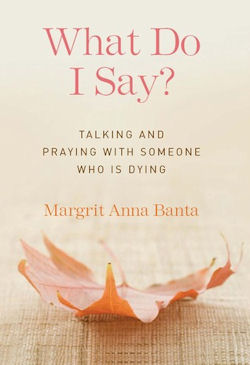
|
Posted February 25, 2015
Book: What Do I Say: Talking and praying with someone who is dying Author: Margrit Anna Banta Franciscan Media. Cincinnati, OH. 2015. Pp. 53 An Excerpt from the Jacket:
People who are dying want to know that they are loved and cared for. Your attentive presence can accomplish this, and What Do I Say? will tell you how. It gives family, friends, and caregivers of the terminally ill a personal and pastoral approach to being with someone who is dying, with suggestions for areas such as important topics to cover and what to do when someone can't communicate. Above all, this book encourages you to provide a steady presence, answering questions when necessary, simply listening at times, and praying with the person when that is desired. An Excerpt from the Book: The Importance of Touch He stretched out his hand and touched him, saying, "I do choose. Be made clean!" Immediately his leprosy was cleansed. Research has shown that a mother's loving touch is essential for a newborn's development. According to the University of Miami Touch Research Institute, newborns who are frequently touched have superior mental and motor skill development. The same research shows that seniors in our society received the least amount of touch of any age group. Yet the findings are clear: among the benefits, touch can lessen pain, slow the heart rate, and help us to relax. Touch is reassuring, healing, nurturing, and helps us feel connected to one another. In Germany, for instance, doctors often prescribe massages to heal specific illnesses, and massage is covered by national health insurance there (Recently, some insurance companies in the United States have approved costs connected with therapeutic massage as well.) Doctors routinely prescribe physical therapy after an illness of injury, as this aids in the healing process. Touch can be an act of kindness when someone is dying. If you visit a sick person and find that you are at a loss for words, reach out and touch her hand. If you are comfortable with the person, you might want to rub her are, or use some hand lotion on her hands. It will convey your care for her and can have a calming effect. It says to the person, "You are appreciated, you are connected, and you are not alone." In our society, touch is something with which we are not always comfortable. We must respect the boundaries people have in regard to being touched. For some people, it can be an uncomfortable experience in general. For others, an illness or condition may make them sensitive to touch. In all cases, we must gauge the level of contact appropriate to the situation. Every one of us has the ability to be a healing presence and provide spiritual companionship to someone who is dying. To touch gently is to give hope --- not the false hope of recovery where none may be possible, but the hope of a tangible presence of God in our lives. I recall visiting an older man in a nursing home who was in the final stages of dying. He had never been married and had no relatives in the area, and there had been no visitors besides me in the months I came to see him. He had lived alone in a small cottage for many years, and I suspect he must have felt very alone and isolated, his need to be touched very strong. On one occasion when I was visiting, the man was trying to tell me something, but I had difficulty understanding him. He was unable to speak in complete sentences and could barely utter a few words. After several attempts to hear him, it turned out that what he was trying to say was, "Hold me." I bent over his bed and put my arms around him, and he relaxed. When the position became uncomfortable for me and I wanted to withdraw, he became agitated, so I continued to hold him until he fell asleep. One of my most vivid memories of a bedside experience occurred when a beloved mother was dying. There was an adult daughter on either side of her bed, each one holding her hand and caressing her arms. She died very peacefully. Table of Contents: 1. Talking with the terminally ill and dying 2. Honesty and denial 3. Unresolved issues 4. The importance of touch 5. Reviewing life 6. Dealing with doubt 7. Final arrangements 8. Approaching the arms of angels 9. Praying with someone who is dying |
|
